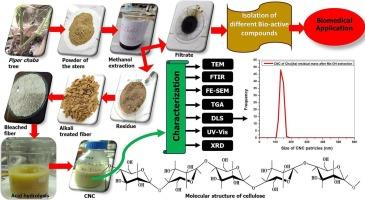从甲醇提取后的恰巴树干残余质量中生产纤维素纳米晶体作为可持续纳米复合材料制造的潜在增强物:废物管理的前沿方法
Q1 Environmental Science
引用次数: 0
摘要
近年来,农业废弃物生物质的可持续利用受到了极大的关注,特别是在生产高价值纳米材料方面。本研究采用序贯物化方法,从恰巴胡椒茎甲醇提取后的残质中有效分离出纤维素纳米晶。选择残余质量是为了通过减少二次污染来促进固体废物管理,并开发一种新的cnc来源,这对零废物战略是有益的。然而,为了验证新生产的cnc的范围,贡献,新颖性,重要性,选择性和适用性,进行了几种最先进的技术,如傅里叶变换红外(FTIR), x射线衍射(XRD),热分析(TGA/DSC),紫外-可见-近红外光谱,场发射扫描电子显微镜(FE-SEM),透射电子显微镜(STEM),动态光散射(DLS)和zeta电位(ZP)分析。FTIR光谱显示非纤维素成分逐渐消除,XRD显示结晶度显着增加,证实了纯化过程的有效性。TGA/DSC表明热稳定性增强。FESEM和STEM揭示了一个装饰良好的二维介孔蜂窝状表面微观结构,具有类似道路的形状,纳米尺度约为100nm。DLS和zeta电位分析证实了高表面负电荷(- 12.5mV),确保了胶体的稳定性。这些增强的物理化学性质使cnc成为生产环境友好的多功能生物纳米复合材料的极有希望的增强材料。这种创新的方法强调了未充分利用的残余质量作为高性能纳米纤维素的有益来源和减少二次污染的潜力。为先进的材料生产、应用和零废物技术提供绿色、经济的解决方案。本文章由计算机程序翻译,如有差异,请以英文原文为准。

Production of cellulose nanocrystals from the residual mass of P. chaba stem after methanol extraction as potential reinforcement in sustainable nanocomposite manufacturing: A cutting-edge approach in waste management
The sustainable utilization of agro-waste biomass has gained significant attention in recent years, particularly for producing high-value nanomaterials. In this research, cellulose nanocrystal (CNCs) was effectively isolated from the residual mass of Piper chaba plant stem after methanol extraction through a sequential physicochemical approach. The residual mass was chosen to facilitate solid waste management by reducing secondary pollution and to develop a new source of CNCs, which can be beneficial in a zero-waste strategy. However, to verify the scope, contribution, novelty, significance, selectivity, and applicability of the newly produced CNCs, several state-of-the-art techniques were conducted like Fourier transform infrared (FTIR), X-ray diffraction (XRD), Thermal analysis (TGA/DSC), UV–vis-NIR spectroscopy, Field emission-scanning electron microscopy (FE-SEM), Transmission electron microscopy (STEM), Dynamic light scattering (DLS), and zeta potential (ZP) analysis. The FTIR spectra indicated the gradual elimination of non-cellulosic constituents, XRD demonstrated a notable increase in crystallinity, confirming the effectiveness of the purification process. The TGA/DSC indicated enhanced thermal stability. FESEM and STEM have revealed a well-decorated 2D mesoporous honeycomb-like surface microstructure with road road-like shape and a nanoscale dimension of approximately 100nm. DLS and zeta potential analyses confirmed a high negative surface charge (−12.5mV), ensuring colloidal stability. These enhanced physicochemical properties make the CNCs a highly promising candidate as reinforcement to produce environmentally friendly polyfunctional bionanocomposites. This innovative approach highlights the potential of underutilized residual mass as a beneficial source for high-performance nanocellulose and to reduce secondary pollution. Offering a green and cost-effective solution for advanced material production, application, and zero waste technology.
求助全文
通过发布文献求助,成功后即可免费获取论文全文。
去求助
来源期刊

Bioresource Technology Reports
Environmental Science-Environmental Engineering
CiteScore
7.20
自引率
0.00%
发文量
390
审稿时长
28 days
 求助内容:
求助内容: 应助结果提醒方式:
应助结果提醒方式:


